Hello there I am new here and I am looking for advice on coax what I want to put together is basically 4 102-in whips each side and vertical over and under the bottom was ones acting as a counterpoise if I did my math correctly and please help me out here I would want my boom out at least a little over 9 ft is this correct? Next question is I wanted to use a T connector and when I go horizontal on the pieces of coaxial cable do I have to run 75 ohms or can I get away with a 50 ohms that split off... Any help would be appreciated thank you!
You are using an out of date browser. It may not display this or other websites correctly.
You should upgrade or use an alternative browser.
You should upgrade or use an alternative browser.
-
You can now help support WorldwideDX when you shop on Amazon at no additional cost to you! Simply follow this Shop on Amazon link first and a portion of any purchase is sent to WorldwideDX to help with site costs.
Co phasing (4) 102" whips vertical?
- Thread starter Mr. Pipeline
- Start date
They make a dipole kit for using dual antennas. It already has everything & all you need are two antennas of the same type or band. Not expensive at all. It makes it far simpler with no guessing. No counterpoise needed.Hello there I am new here and I am looking for advice on coax what I want to put together is basically 4 102-in whips each side and vertical over and under the bottom was ones acting as a counterpoise if I did my math correctly and please help me out here I would want my boom out at least a little over 9 ft is this correct? Next question is I wanted to use a T connector and when I go horizontal on the pieces of coaxial cable do I have to run 75 ohms or can I get away with a 50 ohms that split off... Any help would be appreciated thank you!
Well what I want to do is I know they make a kit for it but do they make a coax already co phased and I do have a ground or ground poise underneath it I just really need to know how wide apart if I did the math correctly that's all but thank you for respondingThey make a dipole kit for using dual antennas. It already has everything & all you need are two antennas of the same type or band. Not expensive at all. It makes it far simpler with no guessing. No counterpoise needed.
Ground plane antennas usually have built in ways of adjusting the match and are easily tuned to 50Ω, while a dipole made of plain 102" whips is unlikely to be 50Ω on its own without additional matching, especially near another dipole. You must first ensure that the feed points of the dipoles, in their final positions, are 50Ω each for the phasing lines to work right. A quarter wavelength of 75Ω coax will transform a 50Ω impedance to 100Ω, which is exactly what is needed when the two 75Ω cables meet at the tee, two 100Ω loads in parallel once again provide 50Ω for the feed line to the radio (or the two meet right at the 50Ω connector on the radio if the radio is close enough like in mobile setups).
As for the separation distance, which will affect feed point impedance a bit, the ideal separation for the most gain (3dB) is at a half wavelength spacing. At a quarter wavelength spacing (common on trucks because that's all the space there is) the pattern is more of an oval without the distinct nulls in the plane of the antennas (to the sides of the truck). In mobile setups, the less than ideal spacing is actually beneficial, as it gives you more gain up and down the highway without completely nulling the stations to the sides. You don't want to round a corner and completely lose the station you were talking to.
edit: And yes, there are co-phased cables available. Most truck stops carry them. But if you don't first ensure that each antenna has a feed point impedance of 50Ω, it won't work right.
As for the separation distance, which will affect feed point impedance a bit, the ideal separation for the most gain (3dB) is at a half wavelength spacing. At a quarter wavelength spacing (common on trucks because that's all the space there is) the pattern is more of an oval without the distinct nulls in the plane of the antennas (to the sides of the truck). In mobile setups, the less than ideal spacing is actually beneficial, as it gives you more gain up and down the highway without completely nulling the stations to the sides. You don't want to round a corner and completely lose the station you were talking to.
edit: And yes, there are co-phased cables available. Most truck stops carry them. But if you don't first ensure that each antenna has a feed point impedance of 50Ω, it won't work right.
If I read this correct you want to make this out of 4 1/4 wave whips.what I want to put together is basically 4 102-in whips each side and vertical over and under the bottom was ones acting as a counterpoise if I did my math correctly and please help me out here I would want my boom out at least a little over 9 ft is this correct?
Two quarter wave whips for each antenna, then both antennas mounted vertically and co-phased together, is this correct?
It's a basic vertical dipole using 1/4 wave whips instead of copper pipe.
Like this.
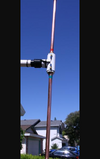
Or a reasonably close thing with mobile mounting brackets as below mounted vertically.
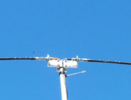
And the answer Brandon gave you about feeding each antennas with a quarter wave of 75 ohm coax is correct.
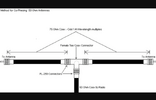
Are you just experimenting or trying to get on the air?
73
Jeff
Last edited:
Hey thank you so much for the input on this this is what I really needed more than anything truly appreciate it thank you!Ground plane antennas usually have built in ways of adjusting the match and are easily tuned to 50Ω, while a dipole made of plain 102" whips is unlikely to be 50Ω on its own without additional matching, especially near another dipole. You must first ensure that the feed points of the dipoles, in their final positions, are 50Ω each for the phasing lines to work right. A quarter wavelength of 75Ω coax will transform a 50Ω impedance to 100Ω, which is exactly what is needed when the two 75Ω cables meet at the tee, two 100Ω loads in parallel once again provide 50Ω for the feed line to the radio (or the two meet right at the 50Ω connector on the radio if the radio is close enough like in mobile setups).
As for the separation distance, which will affect feed point impedance a bit, the ideal separation for the most gain (3dB) is at a half wavelength spacing. At a quarter wavelength spacing (common on trucks because that's all the space there is) the pattern is more of an oval without the distinct nulls in the plane of the antennas (to the sides of the truck). In mobile setups, the less than ideal spacing is actually beneficial, as it gives you more gain up and down the highway without completely nulling the stations to the sides. You don't want to round a corner and completely lose the station you were talking to.
edit: And yes, there are co-phased cables available. Most truck stops carry them. But if you don't first ensure that each antenna has a feed point impedance of 50Ω, it won't work right.
Yes this is pretty much exactly what I'm trying to do I just wasn't sure about the connection of the length of coax and ohms when it crosses the boom basically it's going to look like a field goal type antenna but only 9 ft distance wide total vertically.. am I still in the workable condition for 11 m and 10 m radioIf I read this correct you want to make this out of 4 1/4 wave whips.
Two quarter wave whips for each antenna, then both antennas mounted vertically and co-phased together, is this correct?
It's a basic vertical dipole using 1/4 wave whips instead of copper pipe.
Like this. View attachment 67976
Or a reasonably close thing with mobile mounting brackets as below mounted vertically.View attachment 67978
And the answer Brandon have you about feeding each antennas with a quarter wave of 75 ohm coax is correct.View attachment 67977
Are you just experimenting or trying to get on the air?
73
Jeff
This is what I used for my antenna build, bought at the local Truck stop. This is what I built, I really like it. I got the plans from mower junkie on U tube. Compared to the Antron 99 I ran back in the 90s I'll take this one any day over my old 99. Hope this helps you with your build, when you get the finished product let us know how it's working for you. Enjoy your project, you'll be more proud of that home brew antenna than any store bought one.Hello there I am new here and I am looking for advice on coax what I want to put together is basically 4 102-in whips each side and vertical over and under the bottom was ones acting as a counterpoise if I did my math correctly and please help me out here I would want my boom out at least a little over 9 ft is this correct? Next question is I wanted to use a T connector and when I go horizontal on the pieces of coaxial cable do I have to run 75 ohms or can I get away with a 50 ohms that split off... Any help would be appreciated thank you!
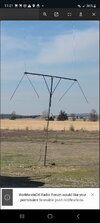
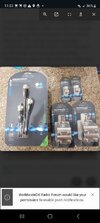
Okay that coax harness you got going on there I assume that's 9 ft on each end correct and also yes I looked at more junkies set up to and that's what really came to mind but instead of screwing into the mask like that I'm using a ham stick setup and I won the cold phase it that way instead of using that in mast because I want to use something light like very heavy duty PVC and clamp on that way and then just go straight across the tops of the boom with two lugs going to each and I just wanted to make sure that was going to work with 75 ohm coaxThis is what I used for my antenna build, bought at the local Truck stop. This is what I built, I really like it. I got the plans from mower junkie on U tube. Compared to the Antron 99 I ran back in the 90s I'll take this one any day over my old 99. Hope this helps you with your build, when you get the finished product let us know how it's working for you. Enjoy your project, you'll be more proud of that home brew antenna than any store bought one.
View attachment 67992View attachment 67991
If I read this correct you want to make this out of 4 1/4 wave whips.
Two quarter wave whips for each antenna, then both antennas mounted vertically and co-phased together, is this correct?
It's a basic vertical dipole using 1/4 wave whips instead of copper pipe.
Like this. View attachment 67976
Or a reasonably close thing with mobile mounting brackets as below mounted vertically.View attachment 67978
And the answer Brandon gave you about feeding each antennas with a quarter wave of 75 ohm coax is correct.View attachment 67977
Are you just experimenting or trying to get on the air?
73
Jeff
This is what I'm using at the moment works pretty good and I figured two together I can make a directional and really get out I shoot skip all over the world with no problems other than getting to Hawaii or the South Pacific like Australia and New Zealand are those areas down thereWell at the moment I have one vertical dipole
Experimenting at this pointIf I read this correct you want to make this out of 4 1/4 wave whips.
Two quarter wave whips for each antenna, then both antennas mounted vertically and co-phased together, is this correct?
It's a basic vertical dipole using 1/4 wave whips instead of copper pipe.
Like this. View attachment 67976
Or a reasonably close thing with mobile mounting brackets as below mounted vertically.View attachment 67978
And the answer Brandon gave you about feeding each antennas with a quarter wave of 75 ohm coax is correct.View attachment 67977
Are you just experimenting or trying to get on the air?
73
Jeff


